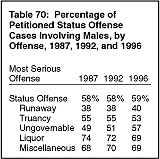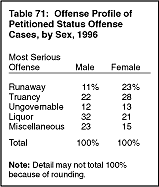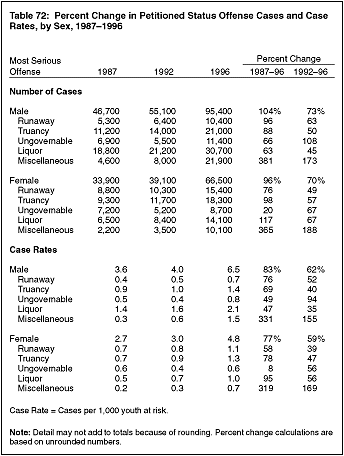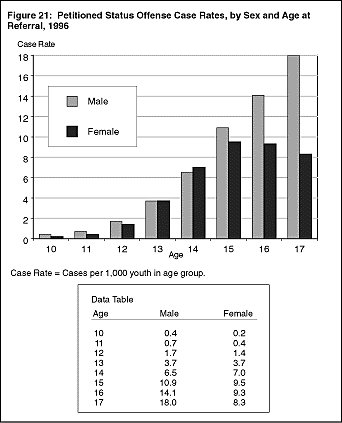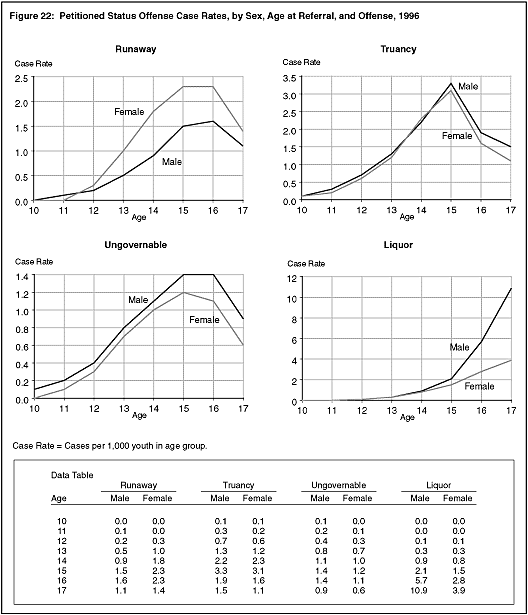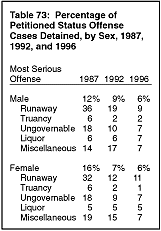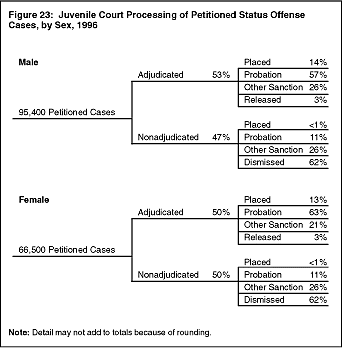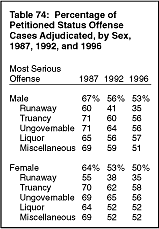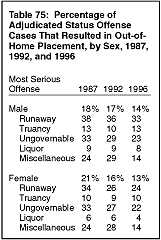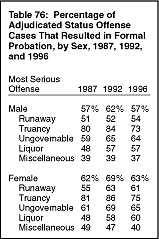|
Males were involved in 59% of petitioned status offense cases in 1996. Males accounted for the majority (69%) of status liquor law violation cases, 57% of ungovernability cases, and 53% of truancy cases, but less than half (40%) of runaway cases (table 70).
The offense profiles of status offense cases for males and females reflect the relatively greater involvement of males in liquor law violations and of females in runaway cases (table 71). Runaway cases accounted for 23% of status offense cases involving females, compared with 11% of cases involving males. In contrast, a liquor law violation was charged in 32% of status offense cases involving males, compared with 21% of cases involving females.
The number of petitioned status offense cases involving females increased 96% between 1987 and 1996, while the number involving males increased 104% (table 72). The largest percent increase among females was for liquor law violations (117%). Among males, the largest increase was for runaway cases (96%).
In 1996, the status offense case rate for males was 6.5 cases per 1,000 males in the juvenile population, compared with 4.8 for females. The case rate difference between males and females was much smaller for status offenses than for delinquency cases. The status offense case rate for males age 16 and older, however, was considerably higher than the rate for females in the same age groups (figure 21). The status offense case rate for females peaked at age 15 then declined through age 17, whereas the case rate for males increased continuously through age 17.
For both truancy and ungovernability cases, the male and female age-specific case rate patterns were comparable, with rates peaking at age 15 (figure 22). By contrast, status liquor case rates were considerably greater for males than for females after age 15. Case rates within the status liquor category increased continuously with age for both males and females, showing large increases in the older age groups. In runaway cases, unlike any of the other status offense categories, the case rate for females was greater than the case rate for males at all but the youngest ages.
Detention
The proportion of status offense cases involving detention was the same for males and females in 1996 (table 73). Detention was used in 6% of all cases involving either sex. For both males and females, runaway cases were more likely than other status offense cases to involve detention (9% for males and 11% for females). The likelihood of detention decreased between 1987 and 1996 for both sexes. The largest decreases were seen in the runaway and ungovernable offense categories. The use of detention among runaway cases dropped from 36% to 9% for males, and from 32% to 11% for females. The use of detention in ungovernability cases dropped from 18% to 7% for both sexes.
Judicial Decision and Disposition
Juvenile court handling of petitioned status offense cases varied little between males and females (figure 23). The proportion of status offense cases adjudicated was 53% for males and 50% for females. The likelihood of adjudication was comparable for males and females across all four major status offense categories (table 74). The likelihood of adjudication declined between 1987 and 1996 in all offense categories for both sexes.
Once adjudicated, the probability of out-of-home placement for petitioned status offense cases was about the same for males (14%) and females (13%) in 1996 (table 75). The overall likelihood of out-of-home placement declined between 1987 and 1996 for both sexes. For ungovernability cases, use of out-of-home placement declined from 33% to 23% (males) and 22% (females). For runaway cases involving females, out-of-home placement declined from 34% to 24%.
For both males and females, the overall proportion of adjudicated status offense cases resulting in formal probation was about the same in 1996 as in 1987 (table 76). The use of probation was essentially the same for males as for females, with female cases slightly more likely than male cases to result in probation for all offense categories. For both sexes, the use of probation increased between 1987 and 1996 in all offense categories except truancy; use of probation for truancy cases declined for both sexes.
|
